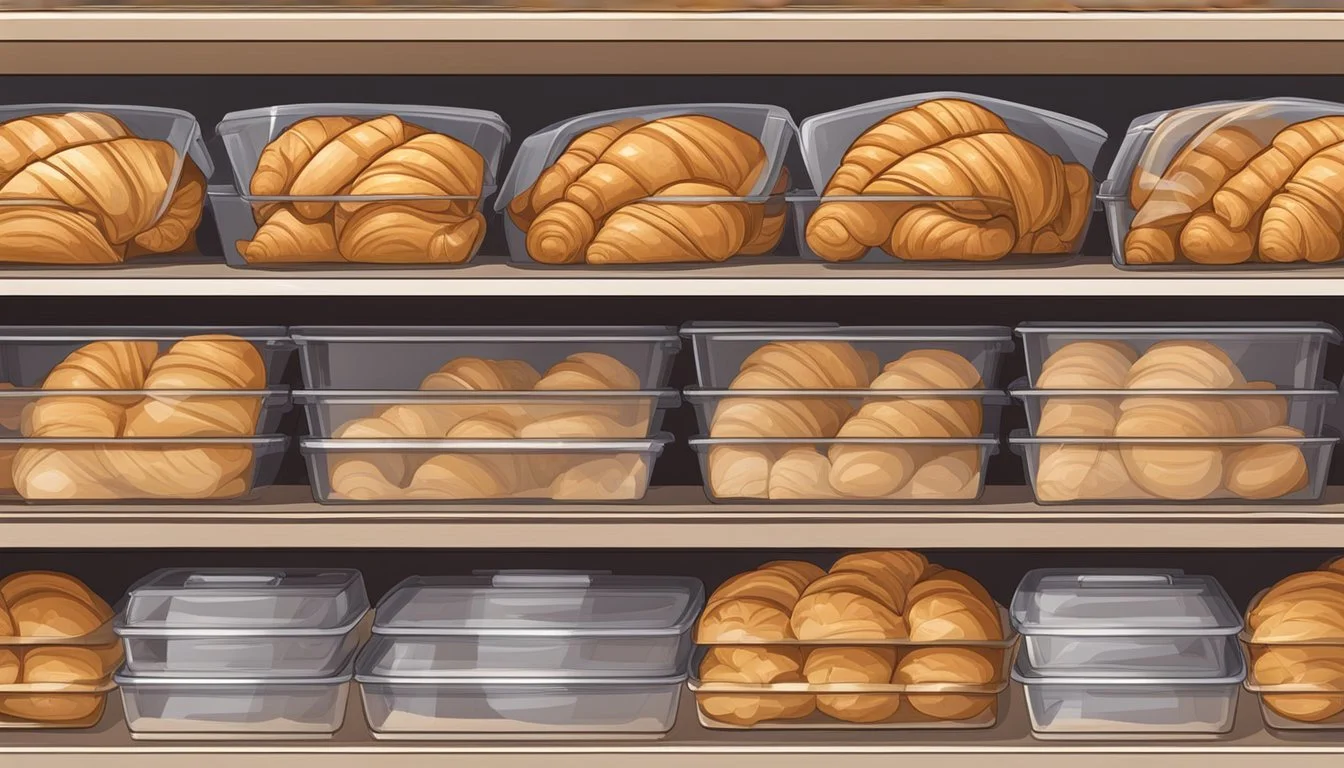Do Croissants Go Bad?
Understanding Shelf Life and Storage Tips
Croissants, those buttery, flaky pastries, are a treat many enjoy, but their delightful texture can be short-lived without proper care. Yes, croissants do go bad, and the key to maintaining their quality lies in how they are stored. Room temperature is suitable for short-term storage, keeping croissants fresh for about 1 to 2 days when kept in an airtight container.
For those looking to extend the lifespan of their croissants, refrigeration can preserve them for up to 5 days. This method involves wrapping the croissants in aluminum foil or placing them in resealable plastic bags. For long-term storage, freezing is effective, allowing croissants to last up to 2 months while maintaining their delicious flavor and texture.
Even stale croissants can be rejuvenated with a quick bake at 320°F for a few minutes. Paying attention to storage methods ensures croissants remain a delicious delight, ready to be enjoyed without the risk of spoilage.
Understanding Croissants
Croissants are a staple of French pastry, renowned for their flaky, buttery texture. They are made using a unique baking process and come in various types with different fillings and shapes.
Composition and Baking Process
Croissants are primarily made from flour, water, yeast, salt, and a generous amount of butter. These ingredients come together through a process known as lamination, where the dough and butter are folded multiple times. This technique creates layers that result in the croissant's distinct flakiness.
Freshly baked croissants often have a golden-brown, crispy exterior with a soft and airy interior. The quality of ingredients, especially the butter, plays a significant role in the final product's taste and texture.
During baking, the heat causes the water in the dough to turn into steam, causing the layers to puff up. This results in the characteristic light and flaky structure that is so prized in croissants.
Types of Croissants
There are several varieties of croissants, each offering a unique experience. Traditional plain croissants are the most common and are enjoyed for their pure, buttery flavor.
Croissants can also be found with various fillings, such as chocolate (popularly known as pain au chocolat), almond paste, or ham and cheese. These filled versions add an extra layer of taste and texture.
Prepackaged croissants available in supermarkets might not match the quality of freshly baked croissants from a bakery but still offer convenience. Additionally, unbaked croissants can be bought frozen and baked at home, allowing for fresh pastries on demand.
Specialty versions like croissant rolls and mini croissants provide more diversity, catering to different preferences and occasions.
Shelf Life of Croissants
Croissants can vary in shelf life depending on storage conditions and methods. Key factors that affect their longevity include temperature, humidity, and preservatives.
Freshness Factors
The freshness of croissants is contingent upon how they are stored. Room temperature storage is most suitable for short-term. Keeping croissants in an airtight container, away from direct sunlight and moisture, can keep them fresh for up to 2 days.
For a slightly longer shelf life, refrigeration is recommended. Wrap croissants in aluminum foil or place them in resealable plastic bags. This method can extend their freshness for up to 5 days.
Freezing croissants is ideal for long-term storage. Properly sealing and freezing them can preserve their quality for up to 2 months. When ready to eat, thaw them at room temperature and reheat in the oven for the best results.
Signs of Spoilage
Several indicators can signify that croissants have spoiled. Texture changes are often the first signs. Stale croissants may become excessively hard or soggy on the exterior.
An off smell is another clear indicator. Fresh croissants should have a pleasant, buttery aroma. If they emit a sour or unusual odor, it is best to discard them.
Discoloration and mold are also telltale signs of spoilage. Look for any unusual spots or color changes on the surface. If any signs of mold appear, it is important to throw the croissants away immediately, as consuming moldy pastries can be hazardous to health.
Proper Storage Techniques
Croissants are best enjoyed fresh but can be stored to extend their shelf life. Different storage methods suit different needs, whether it’s short-term or long-term preservation.
At Room Temperature
For short-term storage up to 2 days, croissants should be kept at room temperature. Store them in an airtight container or wrap them in plastic wrap or aluminum foil to keep them from drying out. Avoid direct sunlight and moisture by choosing a cool, dry place like a pantry. This method retains the fresh quality and flavor of croissants briefly without refrigeration, making them easier to enjoy without preheating.
Refrigerating Croissants
To preserve croissants for up to 3-5 days, refrigeration is an effective method. For best results, wrap them in aluminum foil or place them in a resealable plastic bag before storing them in the fridge. Using an airtight container or a heavy-duty freezer bag can also help in maintaining freshness. The cool temperature slows down the staling process, but be aware that refrigeration can slightly alter the texture, making the croissants less flaky over time.
Freezing and Thawing Croissants
For long-term storage up to 2 months, freezing is ideal. To freeze croissants, wrap them individually in aluminum foil or place them in resealable freezer bags. For added protection, use heavy-duty freezer bags to prevent freezer burn. When ready to eat, thaw frozen croissants at room temperature for about an hour. To restore their fresh-baked taste, preheat the oven to 375°F (190°C) and bake for about 7 minutes. This method helps maintain quality for extended periods and allows for enjoyment without compromising too much on taste or texture.
Reheating and Serving Tips
To restore the freshness of croissants and find creative uses for stale ones, proper reheating techniques and innovative recipes can significantly improve their texture and quality.
Restoring Freshness and Texture
When croissants lose their crispness, reheating them properly can bring back their flaky, buttery texture.
In the oven, preheat to 350°F (175°C). Place the croissants on a baking sheet and heat for 5-10 minutes. If they're frozen, extend the time to 10-15 minutes. This method ensures they heat evenly and regain their golden crust.
For a quick option, use the microwave. Wrap the croissant in a paper towel, place it on a microwave-safe plate, and heat for 15 seconds. Flip it halfway through. This keeps them from becoming too chewy or dry.
The air fryer at 300°F (150°C) for 3-5 minutes can also restore flakiness without over-baking. Watch them closely to avoid burning.
Creative Uses for Stale Croissants
Stale croissants can be transformed into delicious recipes. One popular option is to make croissant croutons. Cut the croissants into small cubes, toss them with olive oil, salt, and pepper, and bake at 350°F (175°C) for 10-12 minutes until crispy.
Croissant bread pudding is another great use. Tear the croissants into pieces, mix with a custard made of eggs, milk, sugar, and vanilla, and bake at 350°F (175°C) for 35-40 minutes.
For a savory twist, stale croissants can be stuffed with fillings like cheese and ham, then baked until the cheese melts, turning them into warm, satisfying sandwiches.
These techniques and recipes help minimize waste and maximize enjoyment, no matter the croissant's initial condition.
Food Safety Considerations
Croissants can spoil if not stored correctly. Temperature is a key factor. At room temperature, keep them in a cool, dry place. Humidity and direct sunlight can cause mold and staleness.
Signs of Spoilage include:
Mold growth
Off smell
Unusual texture
Storage Guidelines:
Room Temperature (up to 2 days): Store in an airtight container away from sunlight.
Refrigeration (3-5 days): Wrap in aluminum foil or place in resealable plastic bags.
Freezing (up to 2 months): For best longevity, store in airtight freezer bags.
Discard croissants if they show any signs of spoilage. This ensures safety and prevents foodborne illnesses.
Maximizing the Enjoyment of Croissants
To fully savor croissants, it's essential to focus on flavor, freshness, and quality. Keeping croissants in optimal condition enhances their taste and appearance.
Storage Tips
To prevent croissants from becoming soggy or losing their flaky texture, proper storage is crucial. Here's a quick guide:
Storage Method Duration Tips Room Temperature 1-2 days Use an airtight container; avoid sunlight Refrigeration 3-5 days Wrap in aluminum foil or resealable bags Freezing Up to 2 months Place in airtight, freezer-safe bags
Maintaining Freshness
Exposure to air can cause croissants to dry out or become stale. Keeping them in airtight containers minimizes air contact and retains their texture.
Reheating for Maximum Flavor
Reheat croissants using an oven for best results. Preheat to 180°C (350°F), wrap croissants in aluminum foil, and bake for 3-5 minutes. This method preserves the crispy exterior and warm, soft interior.
Avoid Common Pitfalls
Improper storage can lead to limited enjoyment. Avoid leaving croissants uncovered, as this accelerates staleness. Also, refrain from microwaving; it often leads to a loss of texture.
Visual Appeal
Fresh croissants have a pleasing, golden-brown appearance. Proper storage and reheating maintain this characteristic, ensuring the croissants look as delicious as they taste.






